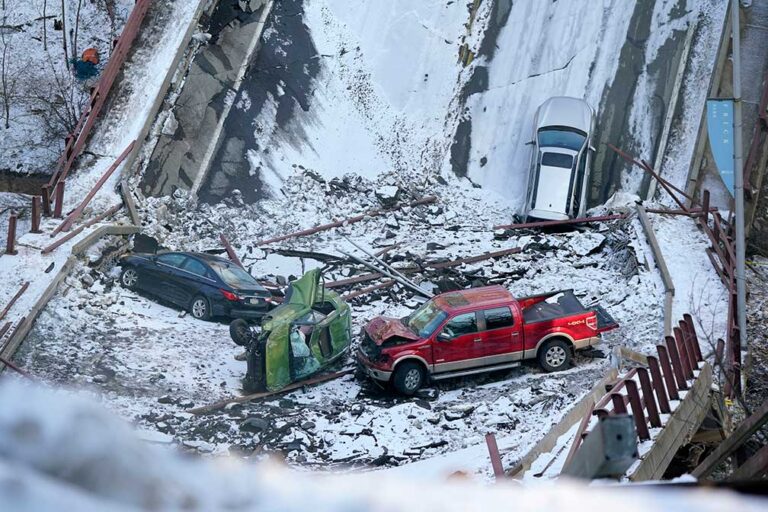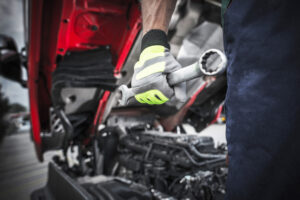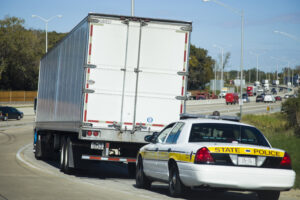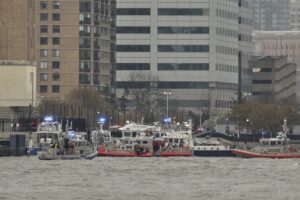WASHINGTON — The city of Pittsburgh did not adequately maintain or repair a bridge and failed to act on inspection reports, leading to the corrosion of the structure’s steel legs and its collapse into a ravine federal investigators said Wednesday, Feb. 21.
The city-owned Forbes Avenue bridge fell Jan. 28, 2022, plunging a bus and four cars about 100 feet into the Fern Hollow Creek. Another vehicle drove off the east bridge abutment and landed on its roof. There were injuries but no one died.
After investigators presented their findings, three members of the National Transportation Safety Board (NTSB) agreed that poor inspections and insufficient oversight were among the probable causes of the collapse.
“The Fern Hollow Bridge collapse should never have happened,” NTSB chair Jennifer L. Homendy said, describing the incident as a wake-up call.
Homendy cited extensive corrosion to the uncoated weathering steel and “repeated failures to act” on damage to the bridge that was known for years. In some areas, the steel had deteriorated to the point of visible holes in the structure.
“The city of Pittsburgh was responsible for inspecting and maintaining the Fern Hollow bridge,” said NTSB senior structural engineer Dan Walsh. “Similar maintenance and repair recommendations were made in the inspection reports for more than 15 years leading up to the collapse. But the city failed to act on them, resulting in progressive corrosion to the point of failure.”
The office of Pittsburgh Mayor Ed Gainey said the administration does not dispute the NTSB findings and noted the bridge inspections were performed by consultants. The city has created a new Bridge Maintenance Division and increased funding for bridge maintenance and repairs by 300%.
Pittsburgh communications director Maria Montaño said in an email that the city has since examined inspection reports for all the bridges it owns “and has been working diligently to address all critical tasks identified in those reports.” She said most “high priority” tasks have been resolved or are in the process, and the city has reviewed all its bridges’ “fracture critical” components and made sure they are draining properly.
Four people were injured, two of them severely, when the bridge collapsed just hours before President Joe Biden arrived in Pittsburgh to promote spending on infrastructure.
Attorney Steve Barth, who represents bus driver Daryl Luciani in litigation against the city and engineers involved with the bridge, said the NTSB findings confirmed what his own experts had concluded.
Barth said there were “multiple levels of failure, from data collection, recording that data, implementation of any recommendations and then oversight.”
There are at least six lawsuits involving the bridge collapse, Barth said. Luciani needed shoulder surgery, had back and neck injuries and is dealing with post-traumatic stress disorder, Barth said. The accident required Luciani to be out on worker’s compensation for a lengthy period, his lawyer said.
Montaño declined to comment on the pending litigation.
The presentations expanded on findings released by the NTSB last May, when investigators said drainage problems led to the deterioration of the structure’s leg and that debris, dirt and leaves had not been cleared.
The bridge was about 50 years old when it collapsed and had been under a 26-ton posted weight limit, with annual inspections required by the Pennsylvania Department of Transportation since 2014. Investigators said a more accurate inspection would have reduced that to about 6,000 pounds, which may have required its closure.
The board played an animation of the collapse along with video from the bus, operated by the Port Authority of Allegheny County, now known as Pittsburgh Regional Transit. It showed the harrowing moments when the bridge began to fail and then dropped.
The failure began when a steel tie-plate on the bridge’s southwestern leg gave way because of corrosion and structural loss, said NTSB senior accident investigator Dennis Collins. The city also made improper load calculations, in part because paving records did not show the asphalt was twice as thick as inspectors believed, he said.
The city’s bridge inspection program did not identify all the structure’s essential “fracture critical sections” that would require closer monitoring, Collins said.
Steel cables were added to shore up the bridge in 2009, but they were intended as a temporary solution and a long-term fix was not completed.
A new bridge at the site 5 miles (8 kilometers) east of downtown Pittsburgh opened to traffic in December 2022.
The Associated Press is an independent global news organization dedicated to factual reporting. Founded in 1846, AP today remains the most trusted source of fast, accurate, unbiased news in all formats and the essential provider of the technology and services vital to the news business. The Trucker Media Group is subscriber of The Associated Press has been granted the license to use this content on TheTrucker.com and The Trucker newspaper in accordance with its Content License Agreement with The Associated Press.








What inspections &
What maintenance?
Real simple 2 fix: research work detail reports & FIRE all thoze involved butt AFTER charging thoze guilty. Publish a list of ALL EDIFICES/bridges this group of MALEFACTORS had been assigned to.
Next & Last: publish names & addresses of lazy lying slobs.